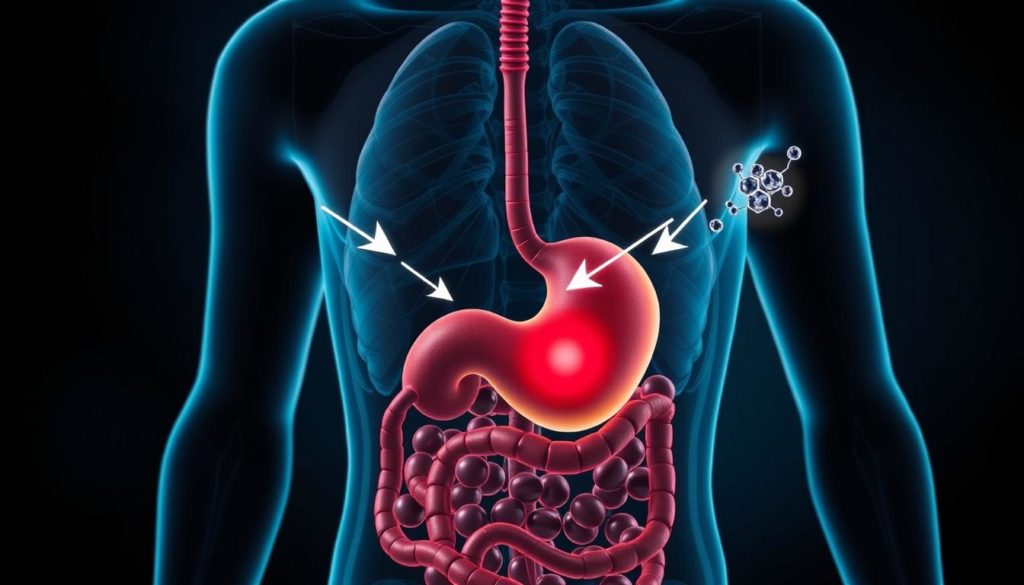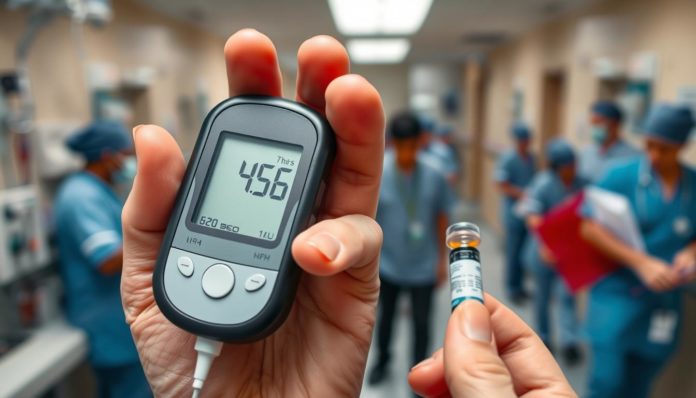Did you know that nearly 1 in 3 children with new diabetes in the US face Diabetic Ketoacidosis (DKA)? This fact stresses the need to be aware of the risks and how to care for this serious condition.
Diabetic Ketoacidosis is a major complication caused by not having enough insulin. It leads to high blood sugar and ketones building up in the body. It is vital for anyone with diabetes or at risk to know the warning signs. They should know when to get emergency help. Fast action and treatment can save lives.
To handle Diabetic Ketoacidosis well, one must follow the guidelines closely and diagnose it quickly. This article covers what you need to know about DKA, from spotting symptoms to how to prevent it. The goal is to arm you with the necessary information to deal with this serious health issue.
What is Diabetic Ketoacidosis?
Diabetic Ketoacidosis (DKA) happens when there’s not enough insulin in your body. Because of this, your body starts to burn fat for energy instead. This leads to ketones building up in your blood, making it acidic. This acidity can be harmful and needs quick treatment at a hospital.

The way this condition unfolds is important to understand. Here’s how it happens in simple terms:
- Insufficient insulin levels
- Increased fat breakdown
- Elevation of blood ketone levels
- Resultant bloodstream acidity
Knowing the symptoms of Diabetic Ketoacidosis is key for catching it early. Look out for signs like a fruity smell on the breath, fast breathing, and confusion. If you notice these, get medical help right away to avoid more serious problems.
For a better grasp, keep these crucial points in mind about DKA:
| Factor | Impact on Body |
|---|---|
| Insulin Deficiency | Triggers fat breakdown |
| Ketone Production | Increases acidity in blood |
| Medical Attention | Critical for stabilization |
| DKA Symptoms | Can be fatal if untreated |
Understanding Diabetic Ketoacidosis deeply shows how serious it is and why the right reaction is crucial. Learning about DKA and watching for its signs can really help in managing and preventing it well.
Diabetic Ketoacidosis Symptoms to Watch For
Diabetic Ketoacidosis (DKA) is a critical health issue that needs quick action. It’s important to catch the signs early for a better outcome. Knowing the early signs of DKA symptoms early detection aids in effective management.

Initial Symptoms
The first signs of DKA might seem like usual sicknesses, making them hard to spot. Keep an eye out for severe thirst, a lot of urinating, feeling sick, throwing up, and being very tired. These happen because of high blood sugar level and are a serious matter. Spotting these early signs is key to getting the right help fast.
Advanced Symptoms and When to Seek Emergency Care
As DKA gets worse, the signs become more severe, showing urgent care is needed. Look for big confusion, stomach pain, breathing hard, and breath smelling fruity. These show high ketone levels in your system. It’s crucial to get medical help right away if blood sugar goes over 300 mg/dL or home tests show a lot of ketones in your pee. Knowing when to get emergency help can stop more serious problems.
| Symptom Stage | Common Symptoms | Action Required |
|---|---|---|
| Initial Symptoms |
| Monitor and manage blood sugar levels |
| Advanced Symptoms |
| Seek immediate DKA emergency care |
DKA Causes: Why It Happens
Learning why Diabetic Ketoacidosis (DKA) occurs is key to stopping and treating it. DKA is mostly caused by problems with insulin therapy. This can be from not taking insulin on time or issues with insulin pumps, disturbing how our bodies handle sugar.
Infections are another big factor that can trigger DKA. Fighting an infection makes our bodies produce more hormones like adrenaline. These hormones fight against insulin, causing blood sugar levels to rise.
Stressful times can also lead to DKA. Things like surgery or injury can increase blood sugar, making it hard for people with diabetes to manage their sugar levels. Emotional stress makes it even tougher, leading to poor diabetes management and DKA.
Some medicines might also set off DKA. These drugs mess with how our bodies use sugar, making us rely on fat for energy instead. This process creates ketones.
| DKA Causes | Description |
|---|---|
| Inadequate Insulin Therapy | Missed doses or malfunctioning insulin pumps disrupt glucose control. |
| Infections | Infections increase insulin-resistant hormones, elevating blood sugar levels. |
| Stress Events | Physical and emotional stress can interfere with blood glucose management. |
| Medications | Drugs that impair carbohydrate metabolism lead to increased ketone production. |
Understanding Diabetic Ketoacidosis
Knowing about Diabetic Ketoacidosis (DKA) starts with its basics. It’s crucial to learn how DKA happens. Also, understanding what makes it worse is important.
Mostly, DKA affects people with type 1 diabetes. Yet, it can also hit those with type 2 in stressful situations. Knowing what increases the risk is vital in Understanding Diabetic Ketoacidosis. The key risks are:
- Type 1 Diabetes
- Severe Illness or Infection
- Medication Interactions
- Missed Insulin Injections
DKA’s cause is a drop in insulin, stopping glucose from entering cells. This spike in blood sugar makes the body use fat for energy. This creates ketones, leading to acidosis, a DKA sign.
Handling DKA well means knowing how important insulin is. The right amount of insulin keeps blood sugar stable. It also stops too many ketones from forming.
Here’s a quick guide to the main points about DKA:
| Factor | Impact on DKA |
|---|---|
| Type 1 Diabetes | High susceptibility to DKA due to insufficient insulin production. |
| Illness or Infection | Triggers stress response, raising blood glucose levels. |
| Medication Interactions | Possible interference with insulin effectiveness. |
| Missed Insulin Injections | Directly causes elevated blood sugar and ketone production. |
Diagnosing Diabetic Ketoacidosis
Finding Diabetic Ketoacidosis (DKA) early is key. This helps stop complications before they start. Doctors use different tests to check for DKA.
Blood Tests and Ketone Levels
Blood tests are vital to diagnose DKA. They check your blood sugar and ketones. Monitoring ketones is very important. Monitoring ketone levels at home can catch DKA early. This can stop serious problems. Using monitoring ketone levels kits at home means quick help if ketones are high.
Clinical Evaluations and Medical History
Doctors also look at symptoms and diabetes care plans. They consider recent sickness or stress too. This is key for a DKA clinical diagnosis. Knowing your health history helps a lot. An accurate medical history evaluation helps doctors make a good treatment plan.
| Diagnostic Methods | Details |
|---|---|
| DKA Blood Tests | Measure blood glucose and ketone levels |
| Ketone Monitoring | Early detection through home test kits |
| Clinical Evaluation | Assessment of symptoms and existing treatments |
| Medical History Evaluation | Identification of precipitating factors like illness or stress |
Treatment for Diabetic Ketoacidosis
DKA treatment starts with giving fluids into the veins. This rehydrates the body. It’s key for patients who lost a lot of fluid because their blood sugar was too high. Along with getting fluids, patients also get electrolytes. This helps balance important minerals like sodium, potassium, and chloride, lost in DKA.
The next big step in treating DKA is giving insulin non-stop. This approach tries to get blood sugar to normal and stop ketones from making acid in the blood. Making sure the insulin therapy stays right is key. Doctors keep a close eye and make changes as needed during recovery.
The table below shows what’s needed for DKA treatment:
| Treatment Component | Purpose |
|---|---|
| Fluid Replacement | Rehydrate the body and improve circulation |
| Electrolyte Replacement | Balance essential minerals like sodium, potassium, and chloride |
| Insulin Therapy | Normalize blood sugar levels and reduce ketone production |
We must also look at why diabetic ketoacidosis started, like an infection or other sickness. Finding and fixing these causes helps patients get better fast. It also stops DKA from happening again.
Complications Arising from Diabetic Ketoacidosis
Managing Diabetic Ketoacidosis (DKA) means using detailed treatments that are vital. However, these treatments can lead to potential side effects. Knowing about these complications helps in recovering more smoothly.
Potential Treatment Complications
Recovering from DKA usually involves important medical steps. This includes insulin therapy and adjusting fluids. While these are crucial for survival, they also carry certain risks.
- Hypoglycemia: Insulin therapy can make blood sugar levels drop too low. This is dangerous if not watched closely.
- Hypokalemia: Adjusting fluids and insulin must be done with care. It prevents a big drop in potassium levels. Potassium is important for the heart and muscles.
Keeping a close eye on electrolyte and sugar levels is key. This avoids the risks that come with DKA treatment. Doctors must manage these factors well to keep patients safe during recovery.
Long-term Health Risks
Not taking care of DKA or letting it happen often can lead to serious long-term health problems. These can affect the body in many ways and harm overall health.
- Cognitive Impairments: If DKA happens often, it can lead to a decline in brain function. This affects memory and how well people can process information.
- Increased Infections Susceptibility: Repeated high glucose levels can weaken the immune system. This makes patients more likely to get infections.
- Organ Damage: Not treating DKA can lead to high blood sugar levels that damage vital organs. This mostly affects the heart and kidneys.
Knowing about these long-term effects is crucial. It shows why managing DKA early and well is important. Keeping blood sugar levels in check and regular monitoring can lessen the risk of these serious complications.
| Complication | Risk Factor |
|---|---|
| Hypoglycemia | Insulin therapy |
| Hypokalemia | Fluid and insulin adjustments |
| Cognitive Impairments | Recurrent DKA |
| Increased Infection Susceptibility | High glucose levels |
| Organ Damage | Persistent high blood sugar |
DKA Prevention Strategies
To avoid Diabetic Ketoacidosis (DKA), good diabetes control and lifestyle changes are key. Keeping an eye on blood sugar levels and following your insulin plan is vital. Also, checking ketones when you’re sick or under stress helps a lot.
Your lifestyle makes a big difference in preventing DKA. Eating well helps keep your blood sugar stable. And staying active boosts your diabetes control even more.
- Monitor blood sugar levels regularly
- Follow prescribed insulin therapy accurately
- Test for ketones during illness or stress
- Adopt a nutritious diet
- Incorporate regular physical exercise
Here’s a quick guide on what matters most for DKA prevention.
| Factors | Details |
|---|---|
| Blood Sugar Monitoring | Frequent checks ensure early detection of abnormalities. |
| Insulin Therapy | Strict adherence helps maintain optimal glucose levels. |
| Ketone Testing | Essential during periods of illness or stress to prevent DKA. |
| Nutrition | Balanced diet aids in stable blood sugar levels. |
| Physical Activity | Regular exercise improves overall diabetes management. |
By following these tips, you can really lower your chance of DKA and get healthier overall.
Effective Diabetic Ketoacidosis Management
Managing Diabetic Ketoacidosis (DKA) requires a multi-step plan. It includes educating patients, accurate diabetes care, and quick medical help. Knowing when to get medical aid and adjusting insulin during sickness is key to reduce DKA risks.
Taught how to check their blood sugar is key for patients. They learn to spot early DKA signs and follow their treatment plans closely. With this knowledge, patients can avoid many DKA episodes.
Working with doctors, patients get a care plan made just for them. Through regular check-ups, treatment can be fine-tuned. This makes it easier for patients to manage their diabetes and lower DKA risks.
Having an emergency plan for DKA is a must. Patients should know when to seek urgent care and handle complications. An organized plan and good communication with their healthcare team can lead to better health and prevent serious DKA issues.
FAQ
What is Diabetic Ketoacidosis?
Diabetic Ketoacidosis (DKA) happens when there’s not enough insulin in the body. This leads to high blood sugar and ketones building up in the blood. It turns the blood acidic and needs quick medical help.
What are the initial symptoms of Diabetic Ketoacidosis?
The first signs of DKA are intense thirst, needing to pee a lot, nausea, vomiting, and feeling tired. These symptoms can show up quickly, so it’s important to act fast.
What are the advanced symptoms of Diabetic Ketoacidosis and when should I seek emergency care?
If you start feeling really confused, have belly pain, find it hard to breathe, or notice your breath smells fruity, these are serious signs. Get emergency help if your blood sugar goes over 300 mg/dL or if at-home tests show a lot of ketones in your pee.
What causes Diabetic Ketoacidosis?
DKA is mostly caused by not having enough insulin, like if you miss doses or there’s a problem with your insulin pump. Infections, stress, or some medicines that affect your blood sugar can also cause it.
How is Diabetic Ketoacidosis diagnosed?
Doctors use blood tests to check your glucose and ketone levels to diagnose DKA. They also look at your health history and do a physical exam.
What are the main treatments for Diabetic Ketoacidosis?
Treating DKA involves getting fluids, electrolytes, and insulin back to normal levels. Doctors also try to fix what caused the DKA. Keeping the blood balanced is key.
What are the potential complications during DKA treatment?
Treatment can sometimes cause low blood sugar or low potassium levels. Because of this, patients need to be watched closely to keep everything in check.
What are the long-term health risks associated with unmanaged Diabetic Ketoacidosis?
Not taking care of DKA can harm your brain, make infections more likely, and damage organs like your heart and kidneys. This is due to long periods of high blood sugar.
How can Diabetic Ketoacidosis be prevented?
To prevent DKA, keep a close eye on your blood sugar, stick to your insulin plan, and check for ketones when you’re sick or stressed. Eating well and staying active are also key.
What are effective strategies for managing Diabetic Ketoacidosis?
Managing DKA well means learning about diabetes, knowing when to seek help, and adjusting insulin when needed. Working with doctors to create a care plan that fits you is crucial.


